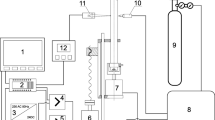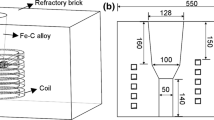Abstract
This research is performed by 2D axis-symmetric finite element simulation based on the coupling of electromagnetic fields and heat transfer applied on 4340 steel specimen with flux concentrators heated by induction process. The model is built using COMSOL software based on an adequate formulation taking into account the material properties and process parameters. The obtained induced currents and temperature distributions are analyzed versus the geometrical dimensions of the model. The originality of this paper lies in the exploitation of simulation data using classical modeling and the optimization techniques to optimize the hardness profile according to geometrical factors. The proposed method is based on finite element simulations and adequate objective function able to converge to the optimal linear hardness profile. The results demonstrate that the final hardness profile can be quasi-uniform with a narrow flux concentrator gap when the gap between the master part and the inductor is larger. This overall study allows a good exploration of hardness profile linearity under various geometrical dimensions and permits a good comprehension of induction heating with flux concentrator behavior.













Similar content being viewed by others
References
Savaria V, et Bridier F, Bocher P (2016) Predicting the effects of material properties gradient and residual stresses on the bending fatigue strength of induction hardened aeronautical gears. Int J Fatigue 85:70–84
Withers PJ (2007) Residual stress and its role in failure. Rep Prog Phys 70:2211–2264
Dmytro RC, Krause FN, Friedrich-Wilhelm B, Lorenz G, Bernd B (2012) Investigation of the surface residual stresses in spray cooled induction hardened gearwheels. Int J Mater Res 103(1):73–79
James MN, Hattingh DG, Asquith D, et Newby M, Doubell P (2016) Applications of residual stress in combatting fatigue and fracture. Procedia Structural Integrity 2:11–25
Besserer H-B, Dalinger A, Rodman D, Nürnberger F, Hildenbrand P, et Merklein M, Maier HJ (2016) Induction heat treatment of sheet-bulk metal-formed parts assisted by water-air spray cooling. Steel Res Int 87:1220–1227
Coupard D, Palin-luc T, Bristiel P, Ji V, Dumas C (2008) Residual stresses in surface induction hardening of steels: comparison between experiment and simulation. Mater Sci Eng A 487:328–339
Deng D (2009) FEM prediction of welding residual stress and distortion in carbon steel considering phase transformation effects. Mater Des 30:359–366
Ivanov D, Markegård L, Asperheim JI, Kristoffersen H (2013) Simulation of stress and strain for induction-hardening applications. J Mater Eng Perform 22:3258–3268
Meo M, Vignjevic R (2003) Finite element analysis of residual stress induced by shot peening process. Adv Eng Softw 34:569–575
Haimbaugh RE (2015) Practical induction heat treating. ASM International, Geauga County
Hömberg D, Liu Q, Montalvo-Urquizo J, Nadolski D, Petzold T, Schmidt A, Schulz A (2016) Simulation of multi-frequency-induction-hardening including phase transitions and mechanical effects. Finite Elem Anal Des 121:86–100
Woodard PR, Chandrasekar S, Yang HTY (1999) Analysis of temperature and microstructure in the quenching of steel cylinders. Metall Mater Trans B 30:815–822
Li Z, Ferguson BL, Nemkov V, Goldstein R, et Jackowski J, Fett G (2014) Effect of quenching rate on distortion and residual stresses during induction hardening of a full-float truck axle shaft. J Mater Eng Perform 23:4170–4180
Kristoffersen H, Vomacka P (2001) Influence of process parameters for induction hardening on residual stresses. Mater Des 22(8):637–644
Nemkov V, Goldstein R, Jackowski J, Ferguson L, Li Z (2013) Stress and distortion evolution during induction case hardening of tube. J Mater Eng Perform 22:1826–1832
Komotori J, Shimizu M, et Misaka Y, Kawasaki K (2001) Fatigue strength and fracture mechanism of steel modified by super-rapid induction heating and quenching. Int J Fatigue 23:225–230
Larregain B, Vanderesse N, Bridier F, et Bocher P, Arkinson P (2013) Method for accurate surface temperature measurements during fast induction heating. J Mater Eng Perform 22:1907–1913
Barka N, et Bocher P, Brousseau J (2013) Sensitivity study of hardness profile of 4340 specimen heated by induction process using axisymmetric modeling. Int J Adv Manuf Technol 69:2747–2756
Barka N (2017) Study of the machine parameters effects on the case depths of 4340 spur gear heated by induction—2D model. Int J Adv Manuf Technol 93:1173–1181
Barka N, Chebak A, El Ouafi A, Jahazi M, Menou A (2014) A new approach in optimizing the induction heating process using flux concentrators: application to 4340 steel spur gear. J Mater Eng Perform 23:3092–3099
Chandler H (1994) Heat treater’s guide: practices and procedures for irons and steels. ASM International
Senhaji A (2017) Simulation numérique de la chauffe par induction électromagnétique d’un disque en AISI 4340. École de technologie supérieure
Floudas CCA, Pardalos PM (2006) Encyclopedia of optimization. Springer-Verlag, Berlin
Wei Z, et Li G, Qi L (2006) New quasi-Newton methods for unconstrained optimization problems. Appl Math Comput 175:1156–1188
Barka N, El Ouafi A, et Bocher P, Brousseau J (2013) Explorative study and prediction of overtempering region of disc heated by induction process using 2D axisymmetric model and experimental tests. Adv Mater Res 658:259–265
Author information
Authors and Affiliations
Corresponding author
Additional information
Publisher’s note
Springer Nature remains neutral with regard to jurisdictional claims in published maps and institutional affiliations.
Rights and permissions
About this article
Cite this article
Khalifa, M., Barka, N., Brousseau, J. et al. Optimization of the edge effect of 4340 steel specimen heated by induction process with flux concentrators using finite element axis-symmetric simulation and experimental validation. Int J Adv Manuf Technol 104, 4549–4557 (2019). https://doi.org/10.1007/s00170-019-04292-y
Received:
Accepted:
Published:
Issue Date:
DOI: https://doi.org/10.1007/s00170-019-04292-y




